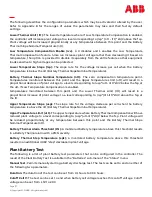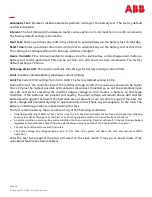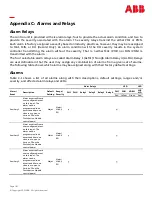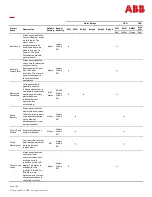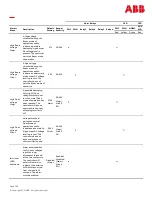
Page 179
© Copyright 2021 ABB. All rights reserved.
Boost Mode
Boost charging is a feature of the QS840A controller, which allows the user to temporarily raise the
plant voltage to a higher, predetermined level in expediting the time needed to charge batteries. The
system may manually be placed in the boost
-
mode through the front panel.
Note that the measured boost voltage may not exactly match the value chosen by the user if the
thermal compensation feature is enabled. This is because the QS840A performs thermal compensated
boost charging and will adjust the boost value based on the battery temperature per the slope chosen
by the user.
The plant will exit the boost mode and enter the float mode if any of the following occurs:
•
The current flowing into the battery string(s) is less than 5A
•
The duration of boost mode charging has reached 8 hours
•
The controller receives either a High
-
Voltage, Rectifier Fail alarm, or High
-
Battery Temperature alarms
•
User sets the plant state to Float via the Controller.
Once initiated, the boost mode may be exited by placing the Plant State to Float.
Auto
-
Boost Charge
This feature may be enabled from the Controller. See Appendix A for details. When enabled, the plant
enters the boost
-
charging mode of operation following a battery discharge once the BD alarm has
been retired, provided the duration of the discharge was greater than 4 minutes. The controller will not
enter the auto
-
boost
-
charging mode if the discharge duration was less than 4 minutes.
When in auto
-
boost mode, the controller raises the plant voltage to the value selected by the user. The
controller keeps the plant in this mode of operation for a minimum of 5 minutes.
The exit conditions for the Auto
-
Boost Charge are the same as those for Boost Charge.
Redundancy Loss Function
This feature must be enabled from the front panel. The controller determines the number of rectifiers
present and compares the actual currents being drawn by the load to that produced by the total
number of rectifiers less one. If the measured load current exceeds the N rectifier
’
s capacity for over 1
min, the alarm condition is activated. The alarm condition is latched on until the Clear Events command
is activated from the front panel.
This feature may be used by customers to determine if the load being served is greater than N
rectifiers worth, in an N+1 system. That is, the load requirements have changed such that the power
system is no longer operating as a redundant power system. An additional rectifier may be required to
ensure continuous redundant operation.
If enabled, this feature will be disabled during battery discharge and recharge conditions. It will be
enabled when the battery charging current falls below 5A.
Summary of Contents for CPS6000
Page 6: ...Page 6 Copyright 2021 ABB All rights reserved This page intentionally left blank Jl ll ll ...
Page 36: ...Page 36 Copyright 2021 ABB All rights reserved This page intentionally left blank Jl ll ll ...
Page 82: ...Page 82 Copyright 2021 ABB All rights reserved This page intentionally left blank Jl ll ll ...
Page 98: ...Page 98 Copyright 2021 ABB All rights reserved This page intentionally left blank Jl ll ll ...
Page 124: ...Page 124 Copyright 2021 ABB All rights reserved This page intentionally left blank ...
Page 146: ...Page 146 Copyright 2021 ABB All rights reserved This page intentionally left blank ...
Page 152: ...Page 152 Copyright 2021 ABB All rights reserved This page intentionally left blank ...
Page 174: ...Page 174 Copyright 2021 ABB All rights reserved This page intentionally left blank ...
Page 188: ...Page 188 Copyright 2021 ABB All rights reserved This page intentionally left blank ...
Page 192: ...Page 192 Copyright 2021 ABB All rights reserved This page intentionally left blank ...
Page 196: ...Page 196 Copyright 2021 ABB All rights reserved This page intentionally left blank ...
Page 198: ...Page 198 Copyright 2021 ABB All rights reserved This page intentionally left blank ...













